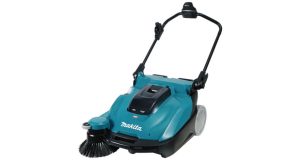 Sustainability is becoming a prerequisite for the cleaning industry, however by linking cost-effectiveness, ability to repair equipment, and efficiency we can create sustainable cleaning solutions which work for cleaners on the ground. To create real change, cleaning solutions which are sustainable and efficient by design are needed. In this feature, Martin Troelsgaard, Global Head of Insights at Nilfisk, highlights how cleaning technologies now offer a holistic solution that can minimise the environmental impact of cleaning.
Sustainability is becoming a prerequisite for the cleaning industry, however by linking cost-effectiveness, ability to repair equipment, and efficiency we can create sustainable cleaning solutions which work for cleaners on the ground. To create real change, cleaning solutions which are sustainable and efficient by design are needed. In this feature, Martin Troelsgaard, Global Head of Insights at Nilfisk, highlights how cleaning technologies now offer a holistic solution that can minimise the environmental impact of cleaning.
All businesses are having to respond to the sustainability agenda. Many are reappraising production and processes, their use of energy sources, and how materials and precious resources are being consumed, to lessen potential environmental harm and act responsibly.
The cleaning industry is not immune from this requirement, with equipment strategies needed to offset the sustainability impact of cleaning activities, but at the same time being mindful of the need to continue to deliver high performing cleaning solutions.
The post-pandemic world has reinforced the importance of strong cleaning regimes that help protect spaces and people. However, to deliver them effectively, and with scrutiny on any associated environmental impact, also requires a careful balancing act.
But companies can take steps to ensure that both aims are tackled. They can use the inherent advantages of today’s advanced cleaning machine technology, together with a sustainably based life cycle offering, to ensure effective cleaning performance is maintained but equipment being used also makes a positive contribution to the ongoing sustainability challenge.
Take a holistic approach
As workforce shortages put increased pressure on productivity and force up labour costs, customers want to see operational reassurance. This relies on machines that can perform for longer, are easy to maintain and suffer from limited downtime occurrences.
To underpin this ambition, customers need to actively consider the total lifecycle cost and viability of cleaning machine solutions. As well as upfront costs, considerations such as ability to repair equipment and serviceability need to be critical specification factors so they have the confidence that machines will perform to their optimum at all times. In-built sensors which can alert operators to potential part failure can pre-empt costly time and resource issues before a major failure occurs and such technology is now increasingly being used to support operational efficiency levels.
Likewise, the ability to quickly service machines so they are out of action for the minimum amount of time must be carefully assessed when selecting cleaning solutions. Machines that keep working help lessen cost burdens and enable time pressurised cleaning contracts to be delivered.
Seeking out modular design answers for cleaning machinery can also aid lifecycle effectiveness. The ability to easily switch out and replace components not only keeps them operational for longer, it also, in many cases, removes the need to replace the machine at all.
All these factors are part of a transparent and collaborative relationship customers and suppliers must have, so the most appropriate cleaning machine is selected but is also a decision-making process that has factored in the need to act in a sustainable manner.
Reuse and recycle
Another key sustainability aspect of machinery deployment is the end of operational life and what to do with the machine that needs replacing. Cleaning professionals who no longer require their old machine or wish to opt for a new purchase can, for example, simply hand it over to Nilfisk as part of an innovative take-back initiative.
In the programme, the device is first carefully inspected and, if necessary, reprocessed. Subsequently, the machine can be used as a high-quality used device. If damage or wear on the machine is too serious, it is professionally recycled by the Nilfisk team of experts with all recyclable raw materials removed, and the rest is disposed of separately.
Sustainable resources use
Sustainability ambitions also extend to waste and resource reduction around material use and packaging. A prime example is the use of water and chemical resources that need to be minimised where possible without compromising cleaning effectiveness.
When it comes to floor cleaning, innovative dosing systems offer tangible economic and effective use of both cleaning chemicals and water. As an example, Nilfisk’s EcoFlex and SmartFlow technology options deliver both intelligent design and uncomplicated handling for operator ease and provide sustainable results.
EcoFlex allows cleaning professionals to adapt exactly to the respective conditions – depending on the type and degree of contamination, different cleaning modes can be activated at the simple push of a button. Through these, the amount of chemicals, water flow and contact pressure is modified so cleaning is always conducted as intensively and as sparingly as possible. With the SmartFlow system, water and detergents are dosed fully automatically. Depending on the speed of the scrubber cleaner, the cleaning solution is applied evenly and highly efficiently. Sustainable and economical cleaning of even large areas is possible without any problems.
In addition to floor cleaning, there are other potential areas for sustainability gain. To dispense with chemical cleaning agents, the use of powerful hot water high-pressure cleaners and steam cleaners can be a simple and efficient alternative. With strong pressure and high temperatures, they remove even the most stubborn dirt and germs of all kinds. Hot water high-pressure cleaners with modern heating technology – such as the Nilfisk EcoPower heat exchanger – achieve excellent cleaning results but consume only a minimum of water and energy and emit extremely few pollutants.
Sustainable power
It is also possible to work more economically during the actual cleaning process with sustainable drive systems now becoming increasingly relevant. As the industry’s first hybrid and ePower combination machine for sweeping and scrubbing in a single operation, the CS7010 from Nilfisk clearly shows how even large, high-performance devices can be used in an environmentally friendly, flexible, and energy-saving manner. As an example, the machine is available with pure electric drive as well as a diesel or LPG hybrid.
Available cleaning technology answers can help the cleaning sector deliver an ongoing, effective, and transparent sustainability contribution, but without compromise to productivity and results. Taking a holistic view about all the primary factors – from lifecycle cost, reliability, and resource use – will ensure the industry can play its part in ensuring a better world for all.





